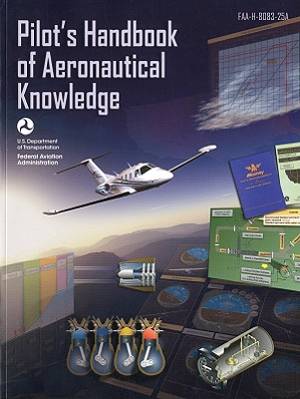
- Retrait gratuit dans votre magasin Club
- 7.000.000 titres dans notre catalogue
- Payer en toute sécurité
- Toujours un magasin près de chez vous
- Retrait gratuit dans votre magasin Club
- 7.000.000 titres dans notre catalogue
- Payer en toute sécurité
- Toujours un magasin près de chez vous
Pilot's Handbook of Aeronautical Knowledge
Description
NOTE: NO FURTHER DISCOUNT FOR THIS PRINT PRODUCT--OVERSTOCK SALE -Significantly reduced list price
Chapter 1: Introduction to Flying offers a brief history of flight, introduces the history and role of the FAA in civil aviation, FAA Regulations and standards, government references and publications, eligibility for pilot certificates, available routes to flight instructions, the role of the Certificated Flight Instructor (FI) and Designated Pilot Examiner (DPE) in flight training, and Practical Test Standards (PTS).
Chapter 2: Aircraft Structure
An aircraft is a device that is used, or intended to be used, for flight, according to the current Title 14 of the Code of Federal Regulations (14CFR) Part I. This chapter provides a brief introduction to the structure of aircraft and uses an airplane for most illustrations. Light Sport Aircraft (LSA), such as wight-shift control, balloon, glider, powered parachute, and gyroplane have their own handbooks to include detailed information regarding aerodynamics and control.
Chapter 3: Principles of Flight
This chapter examines the fundamental physical laws governing the forces acting on an aircraft in flight, and what effect these natural laws and forces have on the performance characteristics of aircraft. To control an aircraft, be it an airplane, helicopter, glider, or balloon, the pilot must understand the principles involved and learn to use or counteract these natural forces.
Chapter 4 Aerodynamics of Flight
This chapter discusses the aerodynamics of flight how design, weight, load factors, and gravity affect an aircraft during flight maneuvers. The four forces acting on an aircraft in straight-and-level, unaccelerated flight are thrust, drag, lift, and weight.
Chapter 5 Flight Controls
This chapter focuses on the flight control systems a pilot uses to control the forces of flight, and the aircraft s direction and attitude. It should be noted that flight control systems and characteristics can vary greatly depending on the type of aircraft flown. The most basic flight control system designs are mechanical and date to early aircraft. They operate with a collection of mechanical parts such as rods, cables, pulleys, and sometimes chains to transmit the forces of the flight deck controls to the control surfaces.
Chapter 6 Aircraft Systems
This chapter covers the primary systems found on most aircraft. These include the engine, propeller, induction, ignition, as well as the fuel, lubrication, cooling, electrical, landing gear, and environmental control systems.
Chapter 7 Flight Instruments
This chapter addresses the pitot-static system and associated instruments, the vacuum system and related instruments, gyroscopic instruments, and the magnetic compass. When a pilot understands how each instrument works and recognizes when an instrument is malfunctioning, he or she can safely utilize the instruments to their fullest potential.
Chapter 8 Flight Manuals and Other Documents
The chapter covers airplane flight manuals (AFM), the pilot s operating handbook (POH), and aircraft documents pertaining to ownership, airworthiness, maintenance, and operations with inoperative equipment. Knowledge of these required documents and manuals is essential for a pilot to conduct a safe flight.
Chapter 9 Weight and Balance
Compliance with the weight and balance limits of any aircraft is critical to flight safety. Operating above the maximum weight limitation compromises the structural integrity of an aircraft and adversely affects its performance. Operations with the center of gravity (CG ) outside the approved limits results in control difficulty.
Chapter 10 Aircraft Performance
This chapter discusses the factors that affect aircraft performance which include the aircraft weight, atmospheric conditions, runway environment, and the fundamental physical laws governing the forces acting on an aircraft.
Chapter 11 Weather Theory
This chapter explains basic weather theory and offers pilots background knowledge of weather principles. It is designed to help them gain a good understanding of how weather affects daily flying activities. Understanding the theories behind weather helps a pilot make sound weather decisions based on reports and forecasts obtained from a Flight Service Station (FSS) weather specialist and other aviation weather services.
Be it a local flight or a long cross-country flight, decisions based on weather can dramatically affect the safety of the flight.
Chapter 12 Aviation Weather Services
In aviation, weather service is a combined effort of the National Weather Service (NWS), Federal Aviation Administration (FAA), Department of Defense, DOD), other aviation groups and individuals.
While weather forecasts are not 100 percent accurate, meteorologists, through careful scientific study and computer modeling, have the ability to predict weather patterns, trends, and characteristics with increasing accuracy. These reports and forecasts enable pilots to make informed decisions regarding weather and flight safety before and during a flight.
Chapter 13 Airport Operations
This chapter focuses on airport operations both in the air and on the surface. By adhering to established procedures, both airport operations and safety are enhanced.
Chapter 14 Airspace
This chapter introduces the various classifications of airspace and provides information on the requirements to operate in such airspace. For further information, consult the AIM and 14 CFR parts 71, 73, and 91.
Chapter 15 Navigation
This chapter provides an introduction to cross-country flying under visual flight rules (VFR). It contains practical information for planning and executing cross-country flights for the beginning pilot.
Chapter 16 Aeromedcial Factors
It is important for a pilot to be aware of the mental and physical standards required for the type of flying done. This chapter provides information on medical certification and on a variety of aeromedical factors related to flight activities.
Chapter 17 Aeronautical Decision-Making
This chapter focuses on helping the pilot improve his or her ADM skills with the goal of mitigating the risk factors associated with flight in both classic and automated aircraft. In the end, the discussion is not so much about aircraft, but about the people who fly them.
Includes Appendix with tables of information, a glossary and an index.
Other titles that may be of interest include theAeronautical Information Manual (AIM)and14CFR --Code of Federal Regulations, Title 14, Aeronautics and Space. These publications combined with thePilot's Handbook of Aeronautical Knowledgecan be used to further U.S. certifications for airman pilot's certifications and pilot training.
Aeronautical Information Manual (AIM)
http: //bookstore.gpo.gov/products/sku/950-074-00000-1
Code of Federal Regulations, Title 14, Aeronautics and Space, Pt. 1-59, Revised as of January 1, 2016
SUBPART C- AIRCRAFT Parts 23, 25,27-33, 35-43 relate to U.S. Federal regulations for standard airwothiness certificates for maintenance, preventive maintenance, and alterations to aircrafts.Part 21 also covers special airwothiness certificate regulations. Part 39 defines Airwothiness Directives (ad).
https: //bookstore.gpo.gov/products/sku/869-084-00043-3
Code of Federal Regulations, Title 14, Aeronautics and Space, Pt. 60-109, Revised as of January 1, 2016can be found here: https: //bookstore.gpo.gov/products/sku/869-084-00044-1
Code of Federal Regulations, Title 14, Aeronautics and Space, Pt. 110-199, Revised as of January 1, 2016 can be found here:
https: //bookstore.gpo.gov/products/sku/869-084-00045-0
Code of Federal Regulations, Title 14, Aeronautics and Space, Pt. 200-1199, Revised as of January 1, 2016
Chapter III focus on Commercial Space Transportation licensing regulations, including Part 414 that is dedicated to the Safety Approval Final rules.https: //bookstore.gpo.gov/products/sku/869-084-00046-8
Code of Federal Regulations, Title 14, Aeronautics and Space, Pt. 1200-End, Revised as of January 1, 2016can be found here: https: //bookstore.gpo.gov/products/sku/869-084-00047-6
Aeronautical Information Manual: Official Guide to Basic Flight Information and ATC Proceduresprint subscriptioncan be found here: https: //bookstore.gpo.gov/products/sku/950-074-00000-1?ctid=
Aeronautical Information Publication, United States of America print subscriptioncan be found here: https: //bookstore.gpo.gov/products/sku/950-001-00000-3?ctid=
Federal Aviation Administration Airworthiness Directives, Bk. 2: Small Aircraft, Rotorcraft, Gliders, Balloons, and Airships print subscriptioncan be found here: https: //bookstore.gpo.gov/products/sku/850-002-00000-2?ctid=
Federal Aviation Administration Airworthiness Directives, Bk. 2: Large Aircraft print subscriptioncan be found here: https: //bookstore.gpo.gov/products/sku/850-003-00000-9?ctid=
"Spécifications
Parties prenantes
- Editeur:
Contenu
- Nombre de pages :
- 470
- Langue:
- Anglais
Caractéristiques
- EAN:
- 9780160823671
- Date de parution :
- 24-03-09
- Format:
- Livre broché
- Format numérique:
- Trade paperback (VS)
- Dimensions :
- 208 mm x 272 mm
- Poids :
- 1637 g






